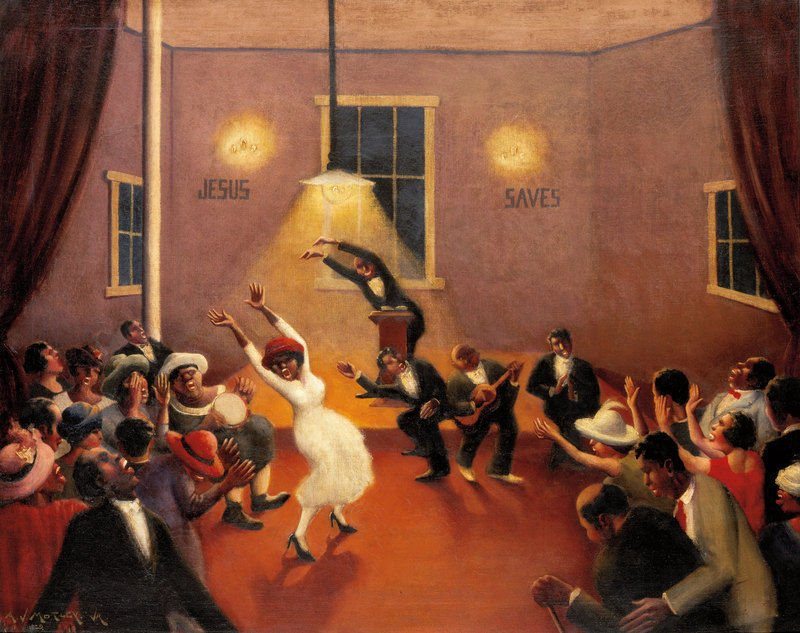Meet the renowned artist who elevated and preserved black culture through paintings in the 1900s. Today, his paintings are studied in top universities around the world as a true depiction of the 1920s and 30s.
Many artists of the Harlem Renaissance found their voice through literature, academics, music and the stage.
Archibald John Motley Jnr was one unique creative who channeled his thoughts on the black community and its development through visual arts.

Even though considered a part of the Harlem Reneissaince, Archibald Motley was one of the very few creatives at the time who made an impact outside of Harlem and New York.
According to several sources, through his parent’s hard work, Archibald enjoyed very quality life and education that had a tell on his preferences and perspectives.
Born to Archibald John Motley Senior, a well to do Pullman Porter and Mary Huff Motley, a school teacher in New Orleans on October 7 1891, he grew up in Chicago after his family moved there for a better life.

Archibald
Furthermore, Archibald was one of the few blacks to attend an all-white school and grow up in a white community.
That exposed him to the portrayal of blacks by the white community.
Moreso, At the early age of 9, he had to work odd jobs after school to support his family after his father fell seriously ill and was hospitalized.
After identifying his talent and interest in visual arts, Archibald worked extra hard in school.
He gained admission into the prestigious Art Institute of Chicago. He became one of the very first black artists to attend the Institute.

Archibald Motley Gettin’ Religion, 1948. Photo whitney.org
It was during his days in the Art Institute of Chicago that Archibald’s interest in race and representation peeked, finding his voice as an artist.
He also realized that several black creatives focused more on history as a muse or inspiration.
While having respect for that, Archibald decided to draw inspiration from present happenings in society as a way of “preserving the now”.
After rejecting a scholarship offer from a friend’s dad to study architecture and later land a good-paying job, Archibald applied for the Guggenheim Fellowship in 1927 but was rejected.
After applying for a second time, he won the fellowship and moved to France to study and gain European influence from some of the world’s greatest artists.

Archibald J. Motley, “Nightlife” (1943). Photo whitney.org
He moved back to America after rejecting 6 months added to his fellowship and began his artistic journey
For his distinctive take on modernism and black evolution.
It wasn’t long until Archibald’s works were noticed by the black community and celebrated among his peers who were part of the black renaissance taking over the USA.

Tongues (Holy Rollers), 1929. Photo whitney.org
Using
The desire for a black Hollywood blended their developing entertainment culture with the white cultures of dances, parties and fashion.
With the boom of Blues and Jazz, Motley’s art also depicted nightlife of the African American community.
He also focused on the representation of African Americans especially through skin tone and physical features.
Moreover, His art raised several controversies and gained the attention of the white community in the USA as well as worldwide recognition, especially in Europe.
Meanwhile, his art did not sit comfortably with others, it won the hearts of several others including top media and critiques like the New York Times.

Tongues (Holy Rollers), 1929. Photo whitney.org
Motley went on to win several awards such as the Harmon Foundation Award and the most popular painting in the USA at the Newark Museum, New Jersey for his Mending Socks piece.
He was also given an honorary doctorate from the School of the Art Institute in 1980 and a Presidential honour by Jimmy Carter in 1980.
Archibald Motley Jnr made history with his one-man show of his works in New York at the New Gallery on Madison Avenue on February 25.
Amazingly, this made him the first artist in the USA to make the front page of the New York Times dubbed the “One-Man Show of Art by Negro, First of Kind Here, Opens Today,”
He sold 22 exhibited painting out of the 26 and also became the first African American to have a portrait of a black subject displayed at Chicago’s Art Institute.

Self-Portrait (Myself at Work), 1933. Photo whitney.org
With his influence in the arts scene, Motley broke racial barriers and paved the way for several other African American artists to gain global recognition and be given a chance with their works.
He also inspired a generation of contemporary artists using their imagination and influences to preserve modern cultures of their immediate environment and use their art as a
Mr Motley died in Chicago on January 16, 1981, leaving behind his white wife, Edith Granzo who he married in 1924 after her parents disowned her for dating a black man.










